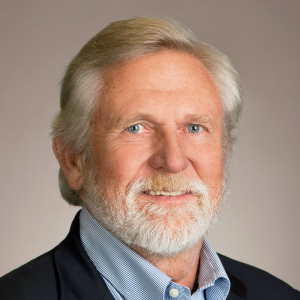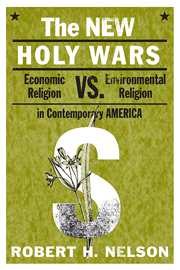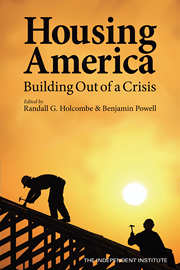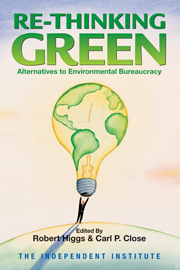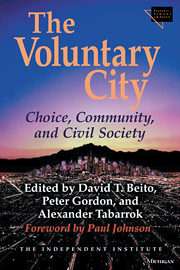The Constitution of the United States forbids the federal government from sanctioning a national church. But what about churches without walls?
---------
Many environmentalists, as well as their critics, acknowledge the religious roots of environmentalism. And for the environmental movement nothing is more sacred than Wilderness. As environmentalists commonly say, wilderness areas are the “churches” of environmentalism. The broader public as well tends to tolerate this characterization, perhaps reflecting a general sense that wilderness areas are indeed very special places.
Few seem willing to address the difficult political question that inevitably follows: If the creation of a wilderness area has a genuinely religious meaning, how can it be reconciled with the longstanding constitutional principle of separating church and state?
If wilderness areas are truly churches of an environmental religion, it follows that when government preserves or protects them, it is engaged in the creation and the management of a national system of churches. It is unacceptable—indeed, unconstitutional—for government to create or manage churches for Christians or Jews. Why, then, should it be acceptable for an environmental religion?
Founding the One True Church
But is it fair to call wildernesses churches?
Wilderness areas can serve as a museum of the biological and geological history of the United States, especially important for a nation that otherwise lacks a long history to record. They also perform several utilitarian functions: recreation, watershed protection, scientific research, etc. However, most of these are also served by many other areas of the national parks, national forests and other public lands that are neither designated nor protected as wilderness. Plainly, serving these human needs is not what specifically characterizes land designated as wilderness.
The distinguishing character of wilderness is defined in the Wilderness Act of 1964: a wilderness must be “an area where the earth and its community of life are untrammeled by man,” and should still exhibit a “primeval character and influence.” As envisioned by Congress, a wilderness area thus constitutes a place for contemplating the condition of the earth as it was originally created—or at least as it existed before human activities transformed its character. As the Los Angeles Times explained on the 25th anniversary of the Wilderness Act, “Americans need places where they can wander off at their own pace to experience the grandeur and sublimity of nature that is unaffected by man. They can look in the waters of a mountain lake and see themselves in new ways.” In a wilderness area it is possible to “witness the world anew. . . . Their thoughts can soar with the eagles.”[1]
Solitary contemplation, leaming about creation, deep spiritual feeling, and emotional replenishment are generally experienced in a church. And, as historian William Dennis has written, many early advocates of wilderness protection explicitly identified their church: “Wilderness was to be the Temple and the Cathedral for ages to come.”[2] One early wilderness enthusiast stated that “my God is in the wilderness. . . . My church is the church of the forest.”[3]
The writings of John Muir in particular are filled with references to the religious character of wilderness. He describes primitive areas as “temples” and trees as “psalm-singing.” Of the wilderness he wrote that “everything in it seems equally divine—one smooth, pure, wild glow of heaven’s love.”[4] Roderick Nash, the leading historian of American environmentalism, explains that for Muir the experience of the wilderness was one in which “life’s inner harmonies, fundamental truths of existence, stood out in bold relief.”[5]
More recently, the Wilderness Society explained that it was necessary to preserve wilderness areas because, “Destroy them and we destroy our spirit . . . destroy them and we destroy our sense of values.”[6] Sierra Club chair Michael McCloskey writes that the most important reason for the government to create wilderness areas is that they provide “beacons of hope for all those whose lives are oppressed by lines of traffic, layers of smog, piles of trash, and the menace of toxics. At last, perhaps, we can understand what Thoreau meant when he said: ‘In wildness is the preservation of the world.”’[7]
Nash finds that the “recent concern for nature” is characterized by a “quasi-religious fervor.” Contemporary “ecotheologians” preach the message of a new “gospel of ecology.”[8] A strong advocate for reducing the human presence in the national parks, Joseph Sax, describes himself and fellow preservationists as “secular prophets, preaching a message of secular salvation.” In his much noted recent book, The End of Nature, Bill McKibben states that a pervasive “crisis of belief” exists in our time which has led “many people, including me . . . [to] overcome it to a greater or lesser degree by locating God in nature.”[9]
The Message of Environmental Theology
Many of the environmental faithful ground their convictions in a theology that offers a story of the creation, the fall of man into sin, the possibility of redemption, the character of good and evil, and other traditional religious messages. Indeed, it is its continuity with the western religious heritage that seems to best explain the great public appeal that environmentalism has demonstrated in recent years.
In the message of environmental theology, the earth as originally created was a harmonious and innocent place. At first, mankind did not disrupt this harmony, because people were so few and so dispersed. But this condition did not last. Like the Biblical fall in the Garden of Eden, the rise of human knowledge provoked a fall from grace. Scientific and economic knowledge made possible cities, advanced technology, and, eventually, all of the other sinful products of modern civilization. Thus, Dave Foreman, a founder of the radical environmental organization Earth First!, identifies the “nascency of agriculture” about 10,000 years ago as the beginning of the fall. Agriculture began the process by which human beings became alienated from nature, from themselves. Soon people were corrupted by the evils of “city, bureaucracy, patriarchy, war and empire.”[10] Foreman summarizes the new environmentalist rendition of the familiar story:
Before agriculture was midwifed in the Middle East, humans were in the wilderness. We had no concept of “wilderness” because everything was wilderness and we were a part of it. But with irrigation ditches, crop surpluses, and permanent villages, we became apart from the natural world and substituted our fields, habitations, temples and storehouses. Between the wilderness that created us and the civilization created by us, grew an ever-widening rift.[11]
Christian theology has long taught that salvation can be achieved, and the human soul cleansed, only by reversing the effects of the fall, by resisting the temptations of evil, renouncing worldly values, and accepting the harmony ordained by God. In environmental theology, humanity must reject the temptations found in modem scientific and economic knowledge and turn back to the original harmony and innocence of the natural world. This requires a cleansing of the “artificial” impacts of man from the Earth and a recovery of the “natural” existence that existed before the earth was corrupted by pervasive human activity.
Western religion has been characterized by the idea of transcendence—that there is a path by which current pervasive evils can be escaped and the world transformed to reach a new heaven, whether on Earth or in the hereafter. Environmental theology falls within this tradition. It sees the path of salvation as following along a return to a far better time in the past, a return to the environmental Garden of Eden.
A church is a place where the presence of God is felt most intensely and where evil is excluded, to the extent that that is possible. In the same way, the church of environmental faith should be a place where human impact is minimized. John Muir and subsequent environmentalisms put this theological logic into practice when they sought measures to preserve sacred wilderness sites. This theological notion was enacted into law in the Wilderness Act of 1964, which characterized wilderness as a place where the signs of human impact were as few as possible.
Environmental theology resembles Judeo-Christian theology in a number of other ways. Just as Christians believe that human sinfulness once caused God to bring on the great flood, and He instructed Noah that each species must be saved, practitioners of environmental religion believe that man’s sinfulness (in the form of agriculture, industry, and the growth of civilization) has caused (or is causing) a great calamity, which can be survived only by the saving of every species by means of the Endangered Species Act.
The apocalyptic tradition in Christianity sees even greater sinfulness that will ultimately culminate in fire and destruction descending from the heavens. Many contemporary environmentalists hold that ever greater pollution, exhaustion of natural resources, mass starvation, and many other disasters loom before humanity unless it stops its sinful agriculture and industry and the spread of its evil civilization. Just as some Christian preachers made the mistake of giving specific dates, enviro-preacher Paul Ehrlich in 1968 prophesied that overpopulation, food shortages, and other problems would yield worldwide catastrophes by 1980.[12] Just as some Christians preach that a new era of peace and harmony will arise from the ashes of civilization after heaven takes its revenge on sinful man, so some radical environmentalists also preach the possibility of redemption in the moment of disaster; by cleansing the earth of human contamination, ecological devastation could even prove to be the dawn of a new and better world.
Christian martyrs once willingly faced lions and gladiators; environmentalists today place their bodies before whaling ships and timber harvest bulldozers. Early monks such as Simon Stylites perched on Middle East columns to show their devotion to God; today, environmentalists perch in redwood trees to show their devotion to the environment. The language of environmentalism is infused with a terminology of moral approval that is derived from the Judeo-Christian heritage. Thus, the Sierra Club recently wrote to prospective members that men must be “called to action” in order to save the Earth.[13] Environmental literature is filled with stories of the “assault,” “murder,” and “ravaging” of nature, these moral offenses associated with activities to develop resources and thus to sin against the innocence of the natural world. Oil companies are a particular target, said to “rape” the earth by drilling in “virgin” environments.
Environmentalists often preach that men fell into sin by renouncing an original unity with the natural world and by seeking instead to exercise dominion over nature.[14] However, the natural world is frequently not an idyllic place of peace and harmony. It is instead a Darwinian world of survival of the fittest. By this standard, the human conquest of the earth, culminating in the great material advances of the modern age, is an act fully in accord with the laws of nature. If the lion is not to be condemned for wanton acts of cruelty, why should humanity be judged “unnatural” for its subjugation of nature?
Thus, the environmental movement is actually pursuing a goal that many environmentalists have failed to recognize. Environmentalism is not working towards greater unification of man with the natural world but, instead, the adoption of a moral standard that lies outside the natural world. No other species, for example, accepts the obligation to protect the existence of different plant and animal species. The message of humanity apart from and with special responsibilities for the world is in fact a message found in the Bible, where man alone among the creatures of the earth is created in the divine image, and man alone is obligated to be a good steward for all the earth.[15] Thus, in yet another way, environmentalism follows closely the Judeo-Christian heritage.
There is a long tradition in Christianity that sees the pursuit of self-interest and the desire for riches as the work of the devil, one of the sinful consequences of the fall of man. In the Garden of Eden all property was communally held; so it will be for the saved in heaven as well. It is only because men in their current earthly state are so depraved that private property rights are justified and that acquisitive activities are permissible.[16] Theologians as central to western religious history as Augustine and Martin Luther have preached a message in which economic pursuits belong to the dark side of life—the evils of the “earthly city” as opposed to the glories of the “heavenly city.”[17]
Some environmentalists have picked up this sort of thinking. They see the relentless pursuit of profits, especially by large and impersonal corporations, as a destroyer of the environment which will ultimately result in ecological catastrophe if not suppressed. The forces of greed still run rampant in the world today, undermining the prospect of men living in true harmony with nature. The Wilderness Society recently lamented that “wilderness and the environment have become today’s scapegoat, sacrificed on the altar of economic expediency.”[18] In a secular age, it seems that environmentalism is for many people a more acceptable outlet for themes earlier expressed in more orthodox forms of western religion.
The influence of the view that wilderness is sacred—a holy site, a place worthy of reverence—is becoming ever greater in shaping government policies for wilderness. The former chairman of the House Interior Committee, Representative Morris Udall, thus declared that the Arctic National Wildlife Refuge was “a sacred place” and it was for this reason that oil drilling must be ruled out in such an unusually wild area.[19] A language of moral affirmation and theological symbolism is today found throughout national discussions of wilderness (and many other environmental) issues.
The Logic of Separating Church and State
Government has the unique power to regulate, tax, and coerce. The framers of the American Constitution were greatly concerned to protect the citizenry against the improper exercise of this power. The Bill of Rights was one product of this concern, designed to assure freedom of assembly, speech, and religion, among other rights. Americans have long held that government’s coercive power should not be used to impose or to support particular religious groups; hence the First Amendment’s prohibition against the establishment of religion.
This attitude grew partly out of an awareness of the disastrous consequences of religious conflict in Europe. In the 17th century the Thirty Years War between Roman Catholicism and Protestantism resulted in the death of about one-third of the German population. In some respects it might seem that the potential for religious conflict is greater in America because of the diversity of religions within its borders.
But the presence of many religions in the U.S. actually diminished this danger by creating a system of checks and balances. Moreover, the awareness of the threat of religious conflict proved in itself to have a powerful corrective influence. Americans have gone out of their way to avoid circumstances that might lead to religious clashes. The principle of separating church and state has played a much greater role in the American constitutional scheme than in Europe. Indeed, in Europe governments have commonly supported an official state church.
As the violent and destructive history of the 20th century shows, conflicts among religions—whether traditional or secular—can be just as destructive today as in the 17th century. The potential for violence makes no sharp distinction between faiths of traditional and of secular kinds. Indeed, Americans already observe a secular form of separation of church and state in the prohibition against government support for particular political parties. It is no more appropriate for the government to support, say, the American Communist Party—a religious organization of a secular kind—than it is to support the Methodist Church.
Among the issues raised by the religious character of environmentalism are fundamental constitutional questions: Does the First Amendment prohibit government support of environmental religion? Does the creation of government-owned wildernesses violate the principle of separation of church and state?
At first glance these questions might seem a bit silly. After all, environmentalism doesn’t seem to be a religion in the sense that Catholicism, Lutheranism, Judaism, and Methodism are religions. Environmentalism does not have the traditional institutional arrangements that characterize these churches. But to define religion for constitutional purposes as requiring a specific form of institutional arrangement is not reasonable. To do so would imply that the state could actively support the religious institutions of such non-traditional or non-Western religions as Buddhism, Confucianism, and Native American faiths. Such an interpretation defies our understanding of the meaning of religion, by excluding from it the faiths of billions of people around the world that lack the institutional arrangements commonly associated with western religions.
There is a great diversity within the Judeo-Christian tradition in the understanding of the character of God, the divine role in human affairs, the path to salvation, and all manner of other basic questions.[20] Partly reflecting this diversity, the distinction between a secular faith and a traditional religion is fraught with ambiguity. The deists of the 18th century saw God as having created the world, but then having left it to operate according to the laws of nature and without further divine interference—a view that secularists can fairly easily accept.
In the late 19th century the “social gospel” movement offered a message of “social salvation”—the salvation of mankind by the achievement of social and economic progress on earth.[21] Preached from many leading pulpits of American Protestantism, this message was not very much different from the secular salvation preached at the time by socialist thinkers of various types.
Marxism in the first half of the 20th century aroused in many followers a dedication, willingness to sacrifice, and zeal that might well have been the envy of proselytizers of traditional faiths. Joseph Schumpeter wrote of “Marx the Prophet,” arguing that “Marxism is a religion. . . . Marxist socialism belongs to that subgroup which promises paradise on this side of the grave.”[22]
The 19th century was a breeding ground not only for Marxism and socialism but for many other secular faiths as well. The intellectual origins of American environmentalism can be traced to Ralph Waldo Emerson, Henry David Thoreau, and the New England transcendentalists of the mid-19th century. John Muir, the founder of the Sierra Club, was a follower of Emerson.[23] Intellectual historian Arthur Ekirch observes that “transcendentalism was not a formal philosophy but was rather a faith—one might almost say a religious faith.” It was “in the study of nature” that Emerson “sought substitutes for the teaching of the church.” Indeed, standing as an “intermediary between God and man, nature also carried a portion of the divinity to each individual.” It could in fact be said that “nature was the connecting link between God and man” and that his conscience.”[24] To go into a wilderness, therefore, was to be able to hear the voice of God.
Some leading current theologians agree that religion can come in many forms and that a secular faith can constitute a religion in a genuine sense. Richard Neuhaus has observed that many secular systems of belief offer “salvation” and that “our secular contemporaries . . . give other names to their sacred world: western civilization, rationality, liberal values and the such. But for all of us there is a sacredness to the ordered world of meaning. On the other side of order—political, economic, intellectual and emotional—is death and damnation.”[25] Another American theologian, Willis Glover, writes that to describe a secular set of beliefs as a religion “is no mere figure of speech. One’s religion is whatever serves as one’s ultimate source of meaning.”[26]
When religion is understood broadly in these terms, government policies necessarily will often have a religious basis. Merely to pursue social and economic progress can itself be a religious act, because many secular religions find in social progress their road to salvation. Hence, it would make no sense to argue that a constitutional separation of church and state means that government decisions must always be free of religious content. Government actions with respect to slavery, civil rights, help for the poor, and many other matters have long been closely linked to the expression of American religious beliefs and values.
However, when the U.S. government creates and financially supports a place of worship for the benefit of a religion, it has plainly violated its own constitution. In establishing the national wilderness system, government has literally undertaken to manage a system of churches of a secular faith. Other faiths—Judeo-Christian, Marxist, Buddhist, or whatever—have not been so bold as to expect that government should provide their places of worship. One means of rectifying this discriminatory policy would be to privatize the natural wilderness system, giving wilderness churches the same status as the churches of other traditional and secular faiths.
One Public Good, Among Many
Admittedly, there are social benefits of wilderness that go well beyond the existence of a holy place of environmental religion. Many Americans (myself included) visit wilderness areas simply for the pleasure of hiking and other outdoor recreation without subscribing to the environmental faith, just as there are many people who benefit from the activities of traditional church organizations and yet do not subscribe to church beliefs. The beneficial impacts of church assistance for the poor, church educational systems, and other religious endeavors go well beyond the actual membership. The existence of these broader benefits of wilderness preservation no more justifies government support for it than the broader benefits of traditional religions justify government support for them.
Some argue that Americans have never really adhered to the constitutional requirement to separate church and state. Indeed, the American national community has been often portrayed as grounded in the beliefs of a “civil faith.”[27] This faith was derived from the Enlightenment, affirmed in the Declaration of Independence, and embodied in the Constitution.[28] With respect to this secular religion there could be no separation of church and state because in effect the American state has itself been the embodiment of this religion. The public schools, for example, were part of the American national church, assigned the task of spreading the message of the civil faith of America. In short, the principle of separating church and state may have been an American myth, useful as a way of keeping traditional religions from potentially dangerous clashes, but ignored when it came to the tenets of the American national religion.
Whatever success the “civil faith” has achieved in American public life arises from the existence of a true national consensus in America. As long as virtually all Americans more or less agreed with the tenets of the American “civil religion,” the American state could become the embodiment of this religion without much risk of religious conflict. To the extent the American government has followed the prescriptions of this civil faith, it has been following the nearly universal wishes of the American people.
The same cannot be said, however, about environmental religion and the establishment of wilderness areas. Government creation of wilderness churches is an affront to those faithful who believe that the route to salvation is to be discovered in the Bible alone, not in listening to the voice of God as found in nature. In a secular context, the creation of a wilderness is regarded by many as a symbolic statement against the redeeming influence of economic progress, technological advance, and the modem industrial system.
Contrary to popular belief, it is not necessary that government be involved in the preservation of wilderness. Indeed, large land areas are preserved in England by private organizations. To a lesser extent private organizations already play this role in the United States. The environmental movement has shown the capacity to raise large sums of money; some estimates indicate that the leading environmental organizations are now receiving collectively more than $250 million per year. If a substantial portion of these funds were used for the acquisition and maintenance of wilderness—rather than lobbying government for subsidy of wilderness—a large private system of wilderness could be established.
As a government system, wilderness is subject to the uncertainties of politics. Some future war or other crisis could threaten the survival of the system. Public opinion could simply swing in another direction. A private wilderness system would not be exposed to these hazards. Indeed, the very act of raising necessary funds and enlisting volunteers might strengthen public support for the values reflected in the wilderness system. Dennis reports that in early America the spread of stricter separations of church and state did not weaken the churches, but resulted instead in a stronger commitment from the faithful. The turn away from politics released new energies for building the churches themselves.[29]
In a 1961 U.S. Supreme Court decision, Torasco vs. Watkins, Justice Hugo Black wrote that government must not “support any religious activities or institutions, whatever they may be called, or whatever form they may adopt to teach or practice religion.” Justice Black explained that no distinction could be drawn in this regard between “religions based on a belief in the existence of God as against those religions founded on different beliefs.” In the latter category the Justice included “Buddhism, Taoism, Ethical Culture, Secular Humanism, and others” as valid if unconventional religions. Among these “others,” there would seem little choice but to include the beliefs of many current members of the environmental movement. And while Justice Black did not have this specific conclusion in mind, a straightforward extension of his line of reasoning would seem clearly to prohibit the government from operating a system of wilderness churches of an environmental religion.
The continued use of public resources to sustain the churches of our contemporary environmental faith can only prove divisive. Instead of government ownership and management, the national wilderness system should be put in private hands, where it could be sustained by voluntary private contributions—as the churches of institutional religion are today sustained and as the natural areas preserved by private organizations such as the Nature Conservancy are today maintained.
The environmentalists’ cathedrals should be supported in the same way that the man-made cathedrals of the Roman Catholic Church and other religious bodies are sustained. Existing wilderness areas should be transferred to appropriate private owners. New wilderness areas should be created by means of contributions from individual and corporate donors, fees charged for wilderness visitation, and other nongovernmental sources.
Notes
1. “The Power of Wilderness,” Los Angeles Times, April 16, 1989.
2. William C. Dennis, “Wilderness Cathedrals and the Public Good,” The Freeman, May 1987, p. 171.
3. Quoted in Dennis, op cit., p. 171.
4. Quoted in Roderick Nash, Wilderness and the American Mind (New Haven: Yale University Press, 1973), pp. 125–26.
6. Wilderness Society membership solicitations, received by author, undated.
7. McCloskey, “The Meaning of Wilderness,” p. 5.
8. Roderick Frazier Nash, The Rights of Nature: A History of Environmental Ethics (Madison: University of Wisconsin Press, 1989), pp. 6, 9.
9. Bill McKibben, The End of Nature (New York: Random House, 1989), p. 71.
10. Dave Foreman, “The Destruction of Wilderness,” Earth First! (December 11, 1989), p. 10.
12. Paul Ehrlich, The Population Bomb (1968).
13. Sierra Club membership solicitation, received by author, undated.
14. Lynn White, “The Historical Roots of Our Ecological Crisis,” Science (March 1967).
15. See Robert H. Nelson, “Unoriginal Sin: The Judeo-Christian Roots of Ecotheology,” Policy Review (Summer 1990); also Robert H. Nelson, Reaching for Heaven on Earth: The Theological Meaning of Economics (Savage, Md.: Romman and Littlefield, 1991).
16. Justo L. Gonzalez, Faith and Wealth: A History of Early Christian Ideas on the Origin, Significance, and Use of Money (San Francisco: Harper and Row, 1990), p. 117.
17. Ernest L. Fortin, “St. Augustine,” and Duncan B. Forrester, “Martin Luther and John Calvin,” in Leo Strauss and Joseph Cropsey, eds., History of Political Philosophy (Chicago: University of Chicago Press, 1981).
18. Wilderness Society membership solicitation, received by author, undated.
19. Quoted in Richard W. Stevenson, “Political Conflict is Renewed Over Drilling in Arctic Refuge,” New York Times, (September 5, 1990), p. A1.
20. Paul Tillich, A History of Christian Thought: From its Judaic and Hellenistic Origins to Existentialism (New York: Simon and Schuster, 1967).
21. Charles Howard Hopkins, The Rise of the Social Gospel Movement in American Protestantism, 1865–1915 (New Haven: Yale University Press, 1940).
22. Joseph A. Schumpeter, Capitalism, Socialism, and Democracy (New York: Harper Brothers, 1950—first ed., 1942), p. 5.
23. See Stephen Fox, The American Conservation Movement: John Muir and his Legacy (Madison: University of Wisconsin Press, 1985)
24. Arthur A. Ekirch, Man and Nature in America (New York: Columbia University Press, 1963), pp. 47, 49, 51, 52.
25. Richard Neuhaus, In Defense of People: Ecology and the Seduction of Radicalism (New York: Macmillan, 1971), p. 38.
26. Willis B. Glover, Biblical Origins of Modern Secular Culture (Macon, Georgia: Mercer University Press, 1984), p. 150.
27. Robert N. Bellah, “Civil Religion in America,” Daedalus (1967); see also Robert N. Bellah, The Broken Covenant: American Civil Religion in Time of Trial (New York: Seabury, 1975).
28. Walter Lippmann, The Public Philosophy (New Brunswick, N.J.: Transaction Publishers, 1989—first ed., 1955).

